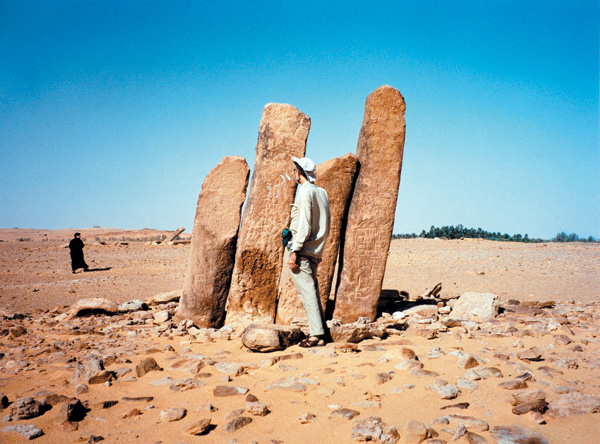
Some of Saudi Arabia’s most important ancient archaeological sites lie in the northwestern province of Al-Jouf, which is bordered on the south by the Nafud, one of the country’s two great deserts.
Until recently, these sites have been inaccessible to visitors. This began to change in 1998, however, when the Kingdom—as most Saudis call their country—opened its doors to foreign tourists who come as part of a group. I was one of the lucky ones.
According to Assyrian annals, King Sennacherib’s army penetrated into Al-Jouf in 688 B.C., attacking “Adumatu [present-day Domat Al-Jandal], the stronghold of the Arabs.” Around 550 B.C., the Babylonians led by king Nabonidus also captured Domat Al-Jandal and incorporated Al-Jouf into the Babylonian empire.
The Nabateans, who controlled the caravan routes between Arabia and the Mediterranean from the first century B.C. through the first century A.D., ruled from Petra in nearby Jordan. Domat Al-Jandal was one of their important trading centers because of its strategic position along the incense routes crossing northwest Arabia.
The Romans under Emperor Trajan annexed Nabatean lands in 106 A.D. Five hundred years later, when Islam swept across the Arabian peninsula, the prophet Mohammed himself led an expedition to Domat Al-Jandal.

Domat Al-Jandal’s history therefore stretches back at least 2,700 years. Nowhere is the feeling of the past more vivid than at Qasr Marid, a picturesque walled fortress that resembles an elaborate sand castle. Although legend says the fort was constructed by a grandson of the biblical prophet Abraham, archaeological excavations carried out there in the 1980s uncovered pottery sherds dating only to the Nabatean era. Roman records mention that Queen Zenobia of Tadmor (present-day Palmyra, Syria) unsuccessfully attacked the fortress in 270 A.D.
Qasr Marid is a labyrinth of crumbling mudbrick, interspersed with towers. As you ascend the steep, narrow steps from one level to the next, you are rewarded with expansive views of the ruins of the ancient town’s streets and houses—some of which are 1,000 years old.
Adjacent to the fortress is the Omar Mosque, built in 634 A.D. by the second caliph, Omar bin Al-Khattab. Its tapered minaret has a passageway through its base leading into the mosque complex. Since this is still a functioning mosque, foreign visitors are usually not permitted to enter, but the caretaker invited our group inside to see the simple interior courtyard and prayer hall.
More archaeological sites are found near the town of Sakaka, 30 miles northeast of Domat Al-Jandal. Much as Domat Al-Jandal is dominated by Qasr Marid, Sakaka is dominated by Qasr Zabal, a fortress dating to the 19th century A.D. While walking up a steep, winding path to reach the mudbrick-and-stone fortress, a sandstone hill comes into view. There, on a large swathe of exposed black stone, figures of joyous dancers are carved into the rock. The carvings date to the pre-Islamic period (prior to the seventh century A.D.).
Four miles south of Sakaka is the mudbrick village of Al-Tuwair, which probably dates to Nabatean times. Extraordinary images—depictions of camels, donkeys, ibexes and ostriches—cover nearby rocks. Intermixed with the petroglyphs are inscriptions carved over a span of 1,000 years.

My favorite archaeological site in Al-Jouf—and certainly one of the most evocative—is Al-Rajajil, 7 miles south of Sakaka. Littering the bleak, sandy area are 50 clusters of stone columns, some still standing 10 feet high. Others tilt precariously, “like a defeated army after a battle,” as one member of our group put it. These mysterious standing stones were raised more than 5,500 years ago by an unknown people for an unknown purpose.

